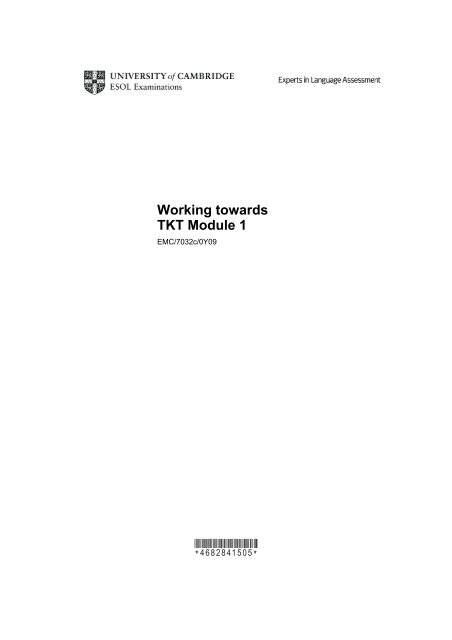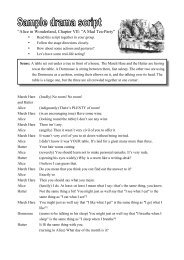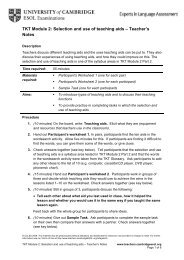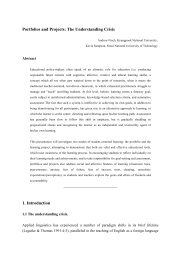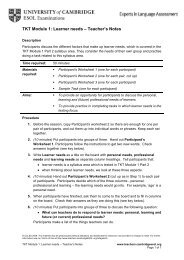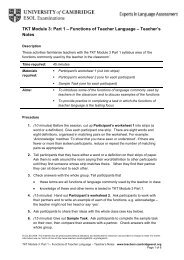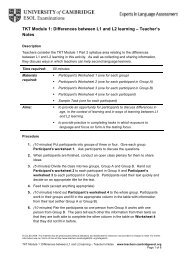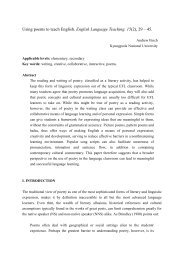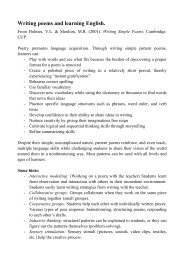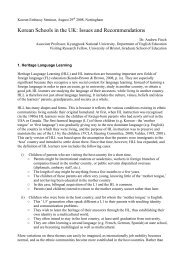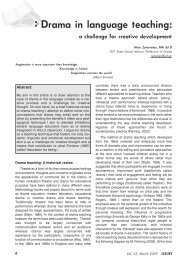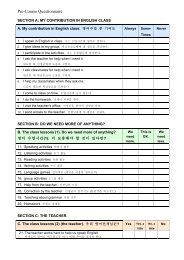Working towards TKT Module 1 - Finchpark
Working towards TKT Module 1 - Finchpark
Working towards TKT Module 1 - Finchpark
- No tags were found...
You also want an ePaper? Increase the reach of your titles
YUMPU automatically turns print PDFs into web optimized ePapers that Google loves.
The <strong>TKT</strong> syllabusMatch the following areas of teaching knowledge from the <strong>TKT</strong> syllabus to one of thethree <strong>Module</strong>s.<strong>Module</strong> 1 <strong>Module</strong> 2 <strong>Module</strong> 3Language and backgroundto language learning andteachingLesson planning and useof resources for languageteachingManaging the teaching andlearning processAreas of teaching knowledgeA) consulting reference resources to help in lesson preparationB) factors in the language learning processC) appropriate terminologyD) options available to the teacher for managing learners and their classroom inorder to promote learning appropriate to the learners and aimsE) concepts and terminology for describing languageF) lesson planning: choosing assessment activities appropriate to learners, aimsand stages of learningG) using language appropriately for a range of classroom functionsH) the range of methods, tasks and activities available to the language teacherI) identifying the functions of learners’ languageJ) selection and use of coursebook materials appropriate to learners and aimsK) concepts and terminology for describing language skillsL) categorising learners’ mistakes.In your group, discuss what other areas of teacher knowledge you might find in oneof the <strong>Module</strong>s.4 WORKING TOWARDS <strong>TKT</strong> MODULE 1 EMC/7032c/0Y09
Part 2Selection and use of resources and materialsUnit 22 Consulting reference resources to help in lesson 106preparationUnit 23 Selection and use of coursebook materials 110Unit 24 Selection and use of supplementary materials and 114activitiesUnit 25 Selection and use of aids 119<strong>TKT</strong> <strong>Module</strong> 2 Practice test 124<strong>Module</strong> 3Part 1Part 2Managing the teaching and learning processTeachers’ and learners’ language in the classroomUnit 26 Using language appropriately for a range of classroom 134functionsUnit 27 Identifying the functions of learners’ language 138Unit 28 Categorising learners’ mistakes 141Classroom managementUnit 29 Teacher roles 145Unit 30 Grouping students 148Unit 31 Correcting learners 152Unit 32 Giving feedback 156<strong>TKT</strong> <strong>Module</strong> 3 Practice test 160Sample <strong>TKT</strong> answer sheet 168Exam tips for <strong>TKT</strong> 169Answer key for Follow-up activities 171Answer key for <strong>TKT</strong> practice tasks 176Answer key for <strong>TKT</strong> practice tests 177Alphabetical list of terms 178Unit by unit list of terms 182Phonemic symbols 187Acknowledgements 188Contents page from Spratt, M, Pulverness, A and Williams, M (2005), The <strong>TKT</strong> Course, Cambridge:Cambridge University Press.6 WORKING TOWARDS <strong>TKT</strong> MODULE 1 EMC/7032c/0Y09
The <strong>TKT</strong> glossary1) Check your definitions against these ones from the <strong>TKT</strong> glossary.• A pronoun is a word that replaces or refers to a noun or noun phrase justmentioned.• A collective noun is a noun that refers to a group of people or things, e.g. thepolice, the government.• A compound noun is a combination of two or more words, which are used as asingle word, e.g. a flower shop, a headache.• An uncountable noun does not have a plural form, e.g. information.• A proper noun is the name of a person or place, e.g. Robert, London.• A plural noun is more than one person, place or thing and can be regular orirregular, e.g. boys, women.2) Now match these words to their definitions from the <strong>TKT</strong> glossary below.FunctionalexponentVerb Function Contraction Intonation Appropriacy Phoneme Context1 2 3 4 5 6 7 8A) The word which follows the subject of a sentence, and is sometimes described as the‘action’ word, e.g. I like cheese; He speaks Italian.B) The situation in which language is used or presented in the classroom and the words orphrases before or after a word which help a student to understand that word.C) A shorter form of a word or words, e.g. you have = you’ve; it is = it’s.D) The smallest sound unit which can make a difference to meaning, e.g. /p/ in pan, /b/in ban.E) The way the level of a speaker’s voice changes, often to show how they feel aboutsomething, e.g. if they are angry or pleased. It can be rising or falling or both.F) A phrase which is an example of a function and shows the purpose of what the speaker iscommunicating, e.g. Let’s ... . This phrase is one way to make a suggestion. It is anexample (or exponent) of the function of suggesting.G) The reason or purpose for communication, e.g. making a suggestion; giving advice.H) Language which is suitable or correct in a particular situation.Access the glossary at: www.cambridgeesol.org/<strong>TKT</strong>WORKING TOWARDS <strong>TKT</strong> MODULE 1 EMC/7032c/0Y09 7
Reading skills1) Discuss this question in your group.Can you think of reasons why learners find reading difficult?2) Now read the Key Concepts section from The <strong>TKT</strong> Course.Key conceptsA text is usually longer than just a word or a sentence. It often contains a series ofsentences, as in a letter or even a postcard. These sentences are connected to one anotherby grammar and vocabulary and/or knowledge of the world. Reading also involvesunderstanding the connection between sentences. For example:The boy was surprised because the girl was much faster at running than he was. Then hefound out that her mother had won a medal for running at the Olympic Games.The second sentence gives us a possible reason why the girl was so good at running. But wecan only understand that this is a reason if we know that Olympic runners are very good. Thismeans we need to use our knowledge of the world to see the connection between these twosentences (coherence). The grammatical links between the sentences (cohesion) also helpus see the connection between them. For example, in the second example sentence ‘he’refers to ‘the boy’ in the first sentence, and ‘her’ refers to ‘the girl’.When we read we do not necessarily read everything in a text. What we read depends onwhy and how we are reading. For example, we may read a travel website to find a singlepiece of information about prices. But we may read a novel in great detail because we like thestory and the characters and want to know as much as we can about them.These examples show us that we read different text types and we read for differentreasons. Some examples of written text types are letters, articles, postcards, stories,information brochures, leaflets and poems. All these kinds of text types are different from oneanother. They have different lengths, layouts (the ways in which text is placed on the page),topics and kinds of language. Learning to read also involves learning how to handle thesedifferent text types.Our reasons for reading influence how we read, i.e. which reading sub-skill (a skill that ispart of a main skill) we use. For example, if we read a text just to find a specific piece orpieces of information in it, we usually use a sub-skill called reading for specific informationor scanning. When we scan, we don’t read the whole text. We hurry over most of it until wefind the information we are interested in, e.g. when we look for a number in a telephonedirectory.Another reading sub-skill is reading for gist or skimming, i.e. reading quickly through atext to get a general idea of what it is about. For example, you skim when you look quicklythrough a book in a bookshop to decide if you want to buy it, or when you go quickly througha reference book to decide which part will help you write an essay.A third reading sub-skill is reading for detail. If you read a letter from someone you lovewho you haven’t heard from for a long time, you probably read like this, getting the meaningout of every word.Another way of reading is extensive reading. Extensive reading involves reading longpieces of text, for example a story or an article. As you read, your attention and interest vary –you may read some parts of the text in detail while you may skim through others.8 WORKING TOWARDS <strong>TKT</strong> MODULE 1 EMC/7032c/0Y09
Sometimes, especially in language classrooms, we use texts to examine language. Forexample, we might ask learners to look for all the words in a text related to a particular topic,or work out the grammar of a particular sentence. The aim of these activities is to makelearners more aware of how language is used. These activities are sometimes calledintensive reading. They are not a reading skill, but a language learning activity.We can see that reading is a complicated process. It involves understanding letters,words and sentences, understanding the connections between sentences (coherence andcohesion), understanding different text types, making sense of the text through our knowledgeof the world and using the appropriate reading sub-skill. Reading may be a receptive skill butit certainly isn’t a passive one!From Spratt, M, Pulverness, A and Williams, M (2005), The <strong>TKT</strong> Course, Cambridge: CambridgeUniversity Press, pp.21–2.Make notes of the points from the Key Concepts.WORKING TOWARDS <strong>TKT</strong> MODULE 1 EMC/7032c/0Y09 9
Listening skills1) Discuss this question in your group.Listening involves understanding spoken language, which is different fromwritten language. What differences can you think of between the spokenand written language of English?2) Now read the Key Concepts section from The <strong>TKT</strong> Course.Written language in EnglishStays on the page and doesn’t disappear.Uses punctuation and capital letters to showsentences.Consists of letters, words, sentences andpunctuation joined together into text.Has no visual support – except photos orpictures sometimes.Is usually quite well organised; sentencesfollow one another in logical sequencesand are joined to previous or followingsentences.Usually uses quite exact vocabulary andmore complex grammar.Spoken language in EnglishDisappears as soon as it is spoken.Sometimes it is spoken fast and sometimesslowly, with or without pauses.Shows sentences and meaningful groups ofwords through stress and intonation.Consists of connected speech, sentences,incomplete sentences or single words.The speaker uses body language to supporthis/her communication; for example, gestures(movements of hands or arms to help peopleunderstand us) and facial expressions (thelooks on our face). This helps the listener tounderstand what the speaker is saying.Is not so well organised; e.g. it containsinterruptions, hesitations, repetitions andfrequent changes of topic.Often uses rather general vocabulary andsimple grammar.To understand spoken language we need to be able to deal with all thecharacteristics of spoken language listed in the table on page 30. Here is an example ofspoken language. You can see that it can be less well organised and less exact than writtenlanguage:FATHER:SON:FATHER:SON:How’s your homework? You know, your history?Easy.You sure?It’s just … I mean all we need to do is, well, just read some stuff.10 WORKING TOWARDS <strong>TKT</strong> MODULE 1 EMC/7032c/0Y09
FATHER:SON:But d’you understand it?Yeah. Can I go and play with Tom?To help us understand spoken language we need to use the context the language isspoken in and our knowledge of the world. In this example, our knowledge of relationshipsbetween fathers and sons, and of children’s attitudes to homework helps us understand, but ifwe knew the context of the conversation (e.g. the place where it took place, the father’s andson’s body language, their attitudes to homework), we would understand more.When we listen, we also need to be able to understand different kinds of spoken texttypes such as conversations, stories, announcements, songs, instructions, lectures andadvertisements. They contain different ways of organising language and different languagefeatures, and some consist of just one voice while others consist of more.We also need to understand different speeds of speech. Some people speak moreslowly and with more pauses. Others speak fast and/or with few pauses. This makes themmore difficult to understand. We need to understand different accents too (e.g. Scottish orAustralian English).But we do not listen to everything in the same way. How we listen depends on ourreason for listening. We might listen for gist, specific information, detail, attitude (listeningto see what attitude a speaker is expressing), or do extensive listening.From Spratt, M, Pulverness, A and Williams, M (2005) The <strong>TKT</strong> Course, Cambridge: CambridgeUniversity Press, pp.30–1.Make notes of the points from the Key Concepts.WORKING TOWARDS <strong>TKT</strong> MODULE 1 EMC/7032c/0Y09 11
<strong>Module</strong> 1 sample task 1For questions 36–40, look at the following terms for language skills and threepossible descriptions of the terms.Choose the correct option A, B or C.Mark the correct letter (A, B or C) on your answer sheet.36 Summarising isA) explaining a text in detailB) writing the last sentence of a textC) giving the main points of a text.37 Interactive listening isA) listening, responding and giving feedbackB) listening for detail, mood and attitudeC) listening and identifying word stress and linking.38 Oral fluency isA) speaking without making any mistakesB) speaking naturally without hesitating too muchC) speaking without considering the listener.39 Paraphrasing isA) using phrases to say something instead of using complete sentencesB) connecting sentences together in speech or writing by usingconjunctionsC) finding another way to say something when you cannot think of theright language.40 Scanning isA) reading a text quickly to get the general ideaB) reading a text quickly to find specific informationC) reading a text quickly to identify the writer’s attitude.12 WORKING TOWARDS <strong>TKT</strong> MODULE 1 EMC/7032c/0Y09
Identifying the steps of the lessonHere are the steps of the lesson you have just watched. Now put them in order.A) The teacher got the children to practise the new language and made sure theywere using it correctly.B) When the teacher was sure the children understood the language and the task,she told them to start.C) The teacher checked that the children understood the meaning of the newlanguage by asking questions.D) The teacher helped the children integrate the new language with language theyalready knew.E) The teacher gave the children instructions for the pair-work activity.F) The teacher introduced the new language with picture cards.G) The teacher monitored the activity.H) The teacher demonstrated the activity she had chosen for them to practise.Step 1: Step 5:Step 2: Step 6:Step 3: Step 7:Step 4: Step 8:How can we describe the stages of this lesson?Video extract from Primary English Teaching (Pearson Education Limited and TheBell School).WORKING TOWARDS <strong>TKT</strong> MODULE 1 EMC/7032c/0Y09 13
<strong>Module</strong> 1 sample task 2For questions 60–66, match the statements with the teaching approaches that theydescribe listed A, B or C.Mark the correct letter (A, B or C) on your answer sheet.Teaching approachesA) Presentation, Practice and Production (PPP)B) Task-based Learning (TBL)C) Grammar–TranslationStatements60The teacher moves from providing models of language use to monitoringlearners’ use of language.6162First the learners complete a communicative task: they are encouraged to useany English they know and they do not have to use any particular languageitem.The written form of the language is more important than the spoken form.63The language focus is at the start of the teaching sequence, with fluencyactivities coming later.64The language focus comes after a communicative activity, so that learnersnotice gaps in their language.65Learners acquire language by trying to use it in real communicative situations.66The learners’ first language plays a central role in the teaching.14 WORKING TOWARDS <strong>TKT</strong> MODULE 1 EMC/7032c/0Y09
Round upA) Briefly discuss and make notes on the following:What aspects of language learning and teaching have you focused on in the tasks for<strong>Module</strong> 1?What different tasks/activities have you done in the session?What different <strong>TKT</strong> task types have you explored?B) Ideas for further developmentPreparationActivitiesContact with other teachersWORKING TOWARDS <strong>TKT</strong> MODULE 1 EMC/7032c/0Y09 15
Possible resources for <strong>TKT</strong>Books about languageLanguage awareness books for teachers, with interactive tasks, commentaries and keys.Some examples include:• Discover English (Bolitho and Tomlinson) Macmillan• About Language (Thornbury) CUP• English for the Teacher (Spratt) CUPBooks about methodologyThose which introduce basic concepts, practices and terminology. Some examples include:• The Practice of English Language Teaching (Harmer) Longman• A Course in Language Teaching (Ur) CUP• Learning Teaching (Scrivener) Macmillan• Teaching Practice (Gower, Phillips and Walters) Macmillan• Teach English (Doff) CUP• Planning Lessons and Courses (Woodward) CUP• Teachers in Action (James) CUP• Looking at Language Classrooms [video resource] (Bampfield) CUPTeachers’ magazinesPractical guidance on classroom teaching (not the more academic journals), for example:• Modern English Teacher (www.onlineMET.com)• English Teaching Professional (www.etprofessional.com)WebsitesThese provide a wealth of background material, for example:• The Cambridge ESOL Teaching Resource (www.cambridgeesol.org/teach)• Teaching English (www.teachingenglish.org.uk)• One Stop English (www.onestopenglish.com)Discussion listsELT e-mail discussion lists such as those at Yahoo Groups or Nicenet.<strong>TKT</strong> practice and preparation materialsThe <strong>TKT</strong> Course (Spratt, Pulverness and Williams) CUP (April 2005)GrammarsUser-friendly grammar reference books, for example:• Practical English Usage (Swan) OUP16 WORKING TOWARDS <strong>TKT</strong> MODULE 1 EMC/7032c/0Y09


